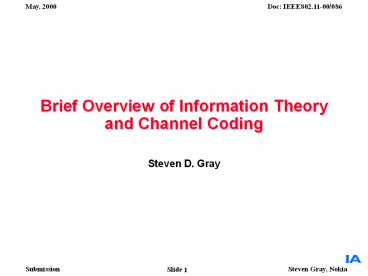Brief Overview of Information Theory and Channel Coding - PowerPoint PPT Presentation
Title:
Brief Overview of Information Theory and Channel Coding
Description:
Brief Overview of Information Theory and Channel Coding Steven D. Gray 1 – PowerPoint PPT presentation
Number of Views:245
Avg rating:3.0/5.0
Title: Brief Overview of Information Theory and Channel Coding
1
Brief Overview of Information Theory and Channel
Coding
- Steven D. Gray
1
2
Outline
- Information theory
- Gaussian channel
- Rayleigh fading channels
- Two approaches for achieving the same rate
- Convolutional encoding
- Convolutional decoding
- Hardware implementation of a Viterbi
- Conclusions
2
3
Brief Introduction to Information Theory
Channel capacity is the highest rate in bits per
channel use at which information can be sent
with arbitrary low probability of error.
3
4
A Little Information TheoryCapacity for the
Gaussian Channel
4
5
A Little Information TheoryCapacity for the Flat
Rayleigh Channel
Average Capacity
where
P is the average power and E is Euler's constant
Source W.C.Y. Lee, "Estimate of Channel Capacity
in Rayleigh Fading Environment," IEEE
Transactions on Vehicular Technology, Vol. 39, No
3, August 1990.
5
6
A Little Information TheoryCapacity Region
Comparison
- For channels of interest (heuristically
speaking) - - Gaussian capacity is an upper bound
- - Flat Rayleigh capacity is a lower bound
6
7
A Little Information Theory Gaussian Channel
Capacity
Shannon Capacity vs. Existing 2.4 GHz Wireless
LAN at 10-6 BER
7
8
A Little Information Theory Conclusions
- Shannon tell us that there is room for
exploitation - Approaches should be pursued to exploit cases
when the SNR is good - With a good code, 20 Mbps is possible in the
Gaussian channel when the SNR is 10 dB or less - Good codes are available with reasonable
complexity
8
9
Two Approaches for Achieving Same Rate
- Approach 1
- Uncoded BPSK modulation
- IEEE802.11a without convolutional coding
- Perfect synchronization and channel estimation
- Rate 12 Mbps
- Additive White Gaussian Noise (AWGN)
- Approach 2
- Coded QPSK modulation
- IEEE802.11a PHY with convolutional coding
- Rate 1/2, 64 state convolutional code
- Perfect synchronization and channel estimation
- Rate 12 Mbps
- AWGN
9
10
Two Approaches for Achieving Same Rate
10
11
Two Approaches for Achieving Same Rate
Conclusion Channel Coding can Improve Spectrum
Efficiency
11
12
Convolutional Encoding
12
13
Convolutional Decoding
- Optimal, bit error rate, decoding is achieved by
maximizing the likelihood function for a given
codeword - Compare the received codeword to all possible
codewords and pick output with smallest distance - Viterbi in 1967 published a dynamic programming
algorithm for decoding - Complexity in decoding is proportional to the
number of states and the number of branches into
each state - Example 64 state code used in PBCC or
IEEE802.11a - 128 metric calculations per transition in the
trellis
13
14
Hardware Implementation of Viterbi
- 64 state code from PBCC and IEEE802.11a
- 32 Add Compare and Select (ACS) units (32
butterflies) - Trace back length is 32 (should be 4 - 5 times
constraint length) - Input is lt3,2,tgt and path metrics are lt10,9,tgt
14
15
Hardware Implementation of Viterbi
- Register Transfer Logic (RTL) synthesis for
Viterbi VHDL is done using Synopsys Design
Compiler - Target for RTL is Xilinx Virtex 1000e Field
Programmable Gate Array (FPGA) - Design complexity
- 55.7K logic gates
- 8Kbytes of Xilinx RAM (4 RAM blocks) for
convience - Actual required RAM is 500 bytes
15
16
Conclusions
- Channel coding is a means to improve spectrum
efficiency over an uncoded system - Particularly for achieving rates above 20 Mbps,
channel coding will make required SNR's
reasonable - Hardware complexity is absorbed in the digital
ASIC - Impact on IC costs are small
- Engineering design costs are always a factor for
a more complex design
16

